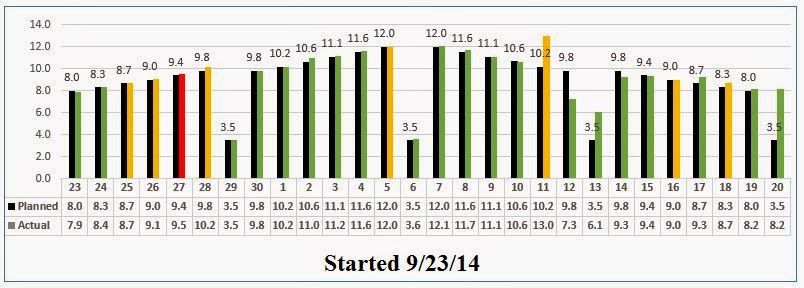|
Virtual Hike
Animated Street View
Remember you bounced the push cart to Missoula from Clarkston or Lewiston? I recommend calling one of the local bicycle shops and seeing if you can send it there. Have them put on some new tires if they are starting to show wear.
It's about 124 miles to the next grocery store in Helena. Plan accordingly.
|
|
Do not be tempted to take the interstate or the frontage road near the interstate. The roads don't go all the way. It would only save 11 miles over the planned route. Besides, the planned route follows a creek much of the way. I was told by the owner of a bicycle shop the water is safe for drinking with filtering.
There aren't many services in this 124 mile stretch, but there are plenty of houses where you can stop to ask for water. Usually, I wait until I see someone outside rather than knocking on a door.
There aren't many services in this 124 mile stretch, but there are plenty of houses where you can stop to ask for water. Usually, I wait until I see someone outside rather than knocking on a door.
Walking Further? Carry Less!
Weight has to be carried or pushed
Many neophyte walkers will see an empty push cart and endeavor to fill it with things they might need. Although it is easier to push weight in a push cart than to carry it in a pack, at some point, it will become an issue. Pushing the cart is only part of the problem. Murphy's law says each time you need something, it will be under everything else.
New road walkers think in terms of comfort items they need. They fill their pack, and because it is heavy to carry, they walk maybe 5 miles to a campsite and live in comfort. This is one style of backpacking people enjoy. What they don't realize is they may walk another 4 or 5 miles in random steps around the campsite. People should do what they enjoy, but this style of backpacking will not work for a 48 state hike.
Experienced backpackers looking to get long miles bring ONLY what they need and nothing else. Instead of walking that 4 or 5 miles in random steps around the campsite, they direct those steps towards the destination. They start early and stop late. They spend most of the time while not walking either sleeping or eating. They know what they NEED to be comfortable, and not what they want to be entertained. The walking is their entertainment!
Don't take it if you don't NEED it!
The only things a walker NEEDS are warmth, shelter, food and water. This means enough clothes, a tent that won't leak, an the minimum food and water needed. A walker doesn't NEED a GPS. A walker doesn't NEED an MP3 player, A walker doesn't NEED a Kindle. A walker doesn't NEED five days of food for a three day walk. A walker doesn't NEED clean clothes every day. There are many things a walker doesn't NEED!
A walker does NEED an excellent sleeping bag and tent as they are the last line of defense against bad weather. It's worth spending $500 on a sleeping bag if it prevents 10 nights in a motel. It's worth spending $400 for a quality tent if it prevents spending rainy nights in a motel. It's worth carrying good rain gear if it gives the ability to walk in the rain.
A walker NEEDS a stove, but they shouldn't carry much extra fuel. Most food can be eaten cold if the walker runs out of fuel.
A walker doesn't NEED three days of food for a three day walk. What? you say! Let's look at this. The walker can eat heartily before setting out the first day. They only need two meals the first day. They can walk hungrily the third day, so they only need one or two meals the third day.
When in doubt, don't take it!
There are plenty of towns in the first few hundred miles of this walk where a walker can buy things they find they NEED. There are also plenty of trash cans to toss stuff they don't NEED.
A concept, not a checklist
I am going to start building a gear list for myself using this concept. It is not meant for others. Others will make different choices. Then I'll start practicing using only things in my push cart each day. Eventually, I'll know what I NEED for comfort and safety. This is intended to encourage anyone contemplating a reality hike to make their own gear choices.
Yesterday's walk without following the training plan proved to be easy. I should get the same number of miles during the cycle as I did with the plan. The only problem is I will be giving up the extra training from the high mile days. I'll work some of those in when I can.






































